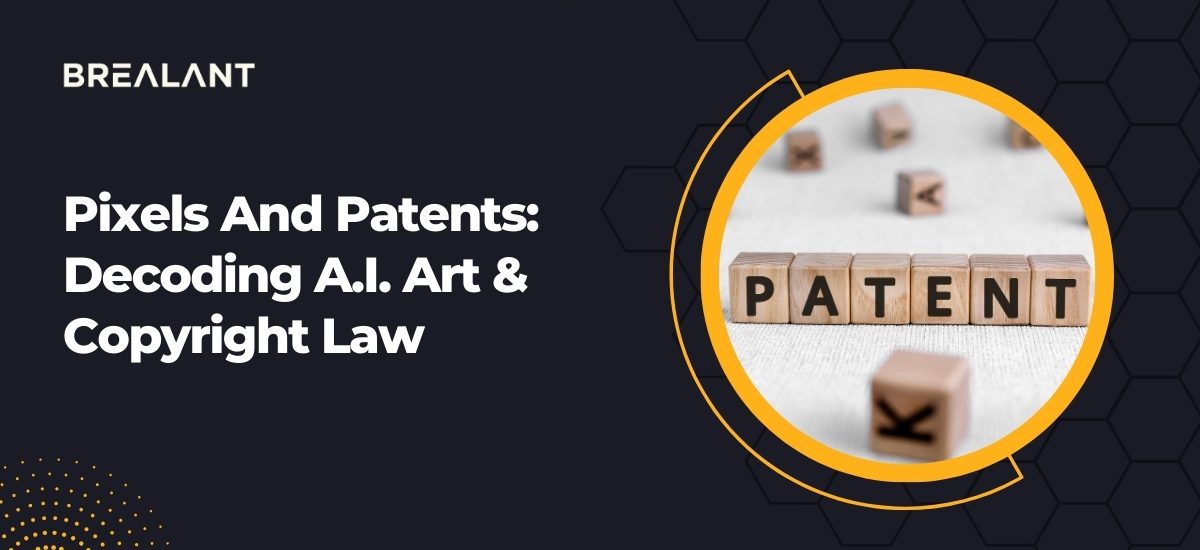



Imagine a world where machines not only mimic artistic expression but create it. The rise of Artificial Intelligence (AI) has ushered in this era, generating stunning visuals, music, and even poetry. But with this creative explosion comes a tangle of legal wires – who owns the copyright to art crafted by AI?
This blog delves into the murky waters of AI art and copyright law. We’ll explore the current legal landscape, examining recent court cases like Stephen Thaler vs. US Copyright Office and Nobody vs. Nobody. We’ll differentiate between copyright protection for artistic expression (pixels) and patent protection for the tools that create it (patents). Finally, we’ll delve into potential solutions for the future, from establishing new intellectual property rights to international legal harmonization.
AI art, also known as generative AI art, refers to artworks created with the assistance of artificial intelligence. Unlike traditional digital art created solely by human artists, AI art utilizes powerful algorithms and machine learning models to generate visuals, music, and even text formats.
Here’s a breakdown of the creative process:
The level of human involvement varies. Some artists utilize AI as a tool, providing intricate prompts and refining the output. Others might use AI to generate variations on a theme, sparking new creative ideas.
AI art can be categorized into different forms:
AI art offers a vast artistic playground, pushing creative boundaries and democratizing art creation. However, with this exciting potential comes a legal gray area – who owns the copyright to these AI-generated works? This question forms the crux of the ongoing debate surrounding AI art and copyright law.
Traditionally, copyright protects original works of authorship created by humans. But AI raises a fundamental question: can a machine be considered an author? Here, the global legal landscape presents a fragmented picture.
A 2022 report by the World Intellectual Property Organization (WIPO) estimates that by 2025, AI-generated content will contribute $4.5 trillion to the global economy. This underscores the urgent need for a more harmonized approach to AI and copyright.
Recent court cases offer a glimpse into the ongoing legal battles surrounding AI art ownership. Let’s explore two significant examples:
These cases demonstrate the complex legal landscape surrounding AI art. As AI technology continues to evolve, so too will the legal interpretation of authorship and ownership.
While copyright protects the artistic expression itself, patents safeguard inventions. This distinction is crucial when dealing with AI art tools.
It’s important to note that patenting the AI engine doesn’t automatically grant ownership of the art it creates.
Does Creativity Need a Human Touch? The Debate Around AI Art Authorship
The rise of AI art raises a fundamental question: can a machine indeed be creative? While AI undeniably possesses impressive capabilities for generating novel and visually striking works, the debate surrounding the human element in creativity remains heated.
Proponents of the “human touch” theory argue that true creativity stems from a wellspring of human experiences, emotions, and cultural understanding. Here’s why human involvement seems crucial:
However, those advocating for AI’s creative potential offer compelling arguments:
The truth likely lies somewhere in between these extremes. While AI might not possess human-like creativity in its current form, it can undoubtedly be a powerful tool for artistic exploration and expression. The key lies in striking a balance – leveraging AI’s capabilities while acknowledging the irreplaceable role of the human artist in conceptualization, emotional depth, and ethical considerations. This collaborative approach can pave the way for a future where AI and human creativity flourish together.
The world of AI art is a dynamic and ever-evolving landscape. As AI technology continues to refine, the creative possibilities and legal complexities will undoubtedly expand. This concluding section offers a glimpse into potential solutions for navigating this exciting yet challenging frontier:
Rethinking Copyright for the AI Age: The current copyright framework, designed for a world of human authorship, might need to address the unique challenges posed by AI-generated works adequately. Here are some potential solutions:
International Harmonization: As AI technology becomes increasingly global, international cooperation is crucial. Establishing a consistent legal framework for copyright protection across different jurisdictions would foster innovation and encourage collaboration among artists and developers worldwide.
The Future of AI Art Collaboration: The most promising path forward might lie in collaboration between AI and human artists. Humans can leverage AI’s capabilities for exploration and iteration while injecting their creativity, emotional depth, and ethical considerations. This collaborative approach can lead to a new era of artistic expression, where technology amplifies human talent.
The Role of Education and Awareness: Educating artists, developers, and the public about the legal and ethical aspects of AI art is crucial. Open discussions about data ownership, bias in training sets, and fair compensation for human contribution can pave the way for a responsible and sustainable future of AI-powered creativity.
The Rise of a New Art Form: AI art has the potential to redefine the very nature of artistic expression. While legal frameworks might need to adapt, there’s no denying the sheer possibility of this evolving art form. As AI technology matures, we might witness the birth of entirely new artistic styles and movements, pushing the boundaries of creativity and challenging our very understanding of art itself.
The journey of AI art has just begun. With careful consideration of the legal and ethical issues, combined with a spirit of collaboration and innovation, we can unlock the immense potential of AI to expand the human capacity for artistic expression and foster a vibrant future for AI-powered creativity.